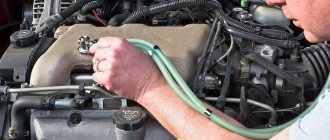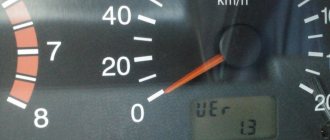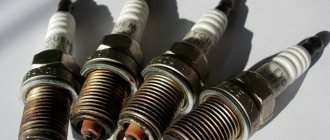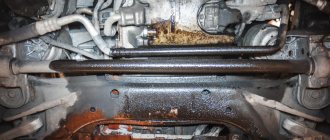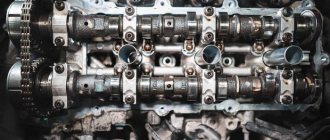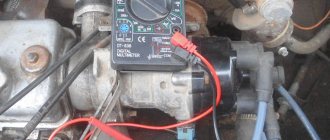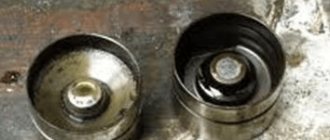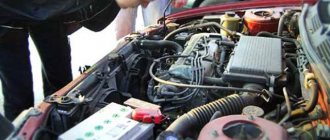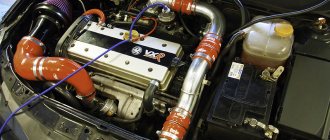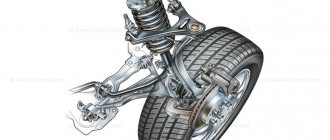The power plant of the VAZ 2114 is an internal combustion engine consisting of two main parts - the cylinder block and the cylinder head, which are a protective housing for the main working units. The camshaft, valves, piston group, cylinders and crankshaft rotate the flywheel, which in turn drives the vehicle's transmission. And all this, when the engine is running, rotates and moves in a forward-return rhythm with enormous frequency, under conditions of vibration and high temperature. The stress on every metal part of this automobile unit is incredibly high, so it is not surprising that parts wear out and sometimes make themselves known through abnormal operation or loud sounds.
What to do if valves are knocking
Extraneous noise in the engine appears most often on cars that the owners do not take care of, and if they do, it is from time to time, and the breaks in these cases are usually very long. An illustration of this can be an analysis of the reasons why valves knock.
The most common reason is increased clearance between the arms and the camshaft cams. And this reason can be eliminated simply by adjusting the valves. And, again, an elementary thing that every driver should know - the valves must be adjusted every fifteen thousand kilometers. This is a mandatory rule.
Careless drivers have had cases when they remembered the valves after 70 thousand miles, and then the car mechanic could not do anything with them, they could not be adjusted.
Car owners often worry about valve knocking on a cold engine. That is, when the engine is cold, there is a clear knocking sound, but as the engine warms up, these sounds disappear. Experienced automobile mechanics explain this by saying that on a car with a fairly high mileage, parts wear out, and this especially happens with parts of the power plant. Small gaps appear between them, which generally do not affect the operation of the systems for the worse, but manifest themselves in a cold state. It is because of these resulting gaps that such annoying sounds appear for drivers. When heated, the metal expands, the gaps disappear, and along with this the unpleasant sound disappears.
However, this does not mean that one should be indifferent to extraneous noise in the engine when it is cold, especially if the owner monitors the timeliness of all adjustments. After all, on a cold engine, at idle speed, the main or connecting rod bearings of the crankshaft can make noise, and this is already very serious. You should definitely contact a specialist for diagnosis.
Every driver heard the valves knocking when hot. Especially with a sharp increase in speed. The most common reason for this is low-quality gasoline. But there may be other reasons, for example, a knock sensor has failed. Or the oil pressure has dropped.
In addition to increasing the clearance, the causes of noise produced by valves can be:
- wear of the camshaft cams - in this case it is necessary to replace the entire camshaft;
- valve spring failure - if this is detected, a new spring must be installed;
- the guide bushing may need to be adjusted or replaced;
- Valve knocking can be caused by completely different reasons, for example, a poorly tensioned timing belt or poor flow of oil through the camshaft to the fingers due to clogged channels in the valve.
It is very difficult for an inexperienced person to determine by ear that the valves on a VAZ 2114 are knocking. Nevertheless, experts recommend some folk remedies, recalling that the camshaft rotates twice as slow as the crankshaft and, accordingly, the sound of the valves should not be frequent. For better sound perception, they suggest placing an empty metal mug to your ear and placing it on the hood. In this case, the sound becomes clear and easy to hear.
An attentive and experienced driver always listens to the sounds of his car. If an unfamiliar knock, noise, or clanging appears in the engine, he will immediately try to determine the cause and nature of this phenomenon. If there is something knocking under the hood, this is a signal of one or another malfunction of the car, which can come out - in the literal sense of the word.
Why is the engine knocking?
Among car enthusiasts who are quite far from professional knowledge of the design and physical essence of the operation of automobile units, but due to long-term driving practice, who consider themselves to be great experts on automobile “guts,” there is an opinion that if a knock appears in the engine, then it is the valves that are knocking. In reality, everything is not so simple. One very experienced automobile mechanic told a case that can serve as a clear illustration of incompetence and disrespect for the opinion of a professional.
Adjustment of valves
“A car arrived at the workshop, the owner asked to adjust the valves. When we started the car for diagnostics, a characteristic knocking sound of the connecting rod in the crankshaft was revealed. This is a clear and unambiguous signal for immediate overhaul; there was no question of any valve adjustment; with such an engine it was impossible to even move away. The owner said that all friends and acquaintances and simply knowledgeable people unanimously affirm that this is the knocking of the valves. I was offended by the car mechanics and got into the car, but I couldn’t get far; a connecting rod broke and pierced the cylinder block. The engine had to be changed."
Instructive story. And she reminds you to read your car's owner's manual and listen to the opinions of professionals. In fact, knocking in the VAZ 2114 engine can be caused by several reasons:
- The crankshaft main bearings are knocking. This is usually a metallic thud. Most often it appears at idle when giving gas.
- The connecting rod bearings are knocking. The sound is sharper than when knocking on the main wheels, and also appears at idle. You can determine the location of the sound source by turning off the spark plugs.
- The pistons knock muffledly and quietly. Often simply replacing the pistons or rings will get rid of this sound.
- Valve knocking, inlet or outlet. The frequency of this sound is less than that from the crankshaft and the sound is slightly different, more sonorous. The causes of valve knocking are varied:
— the gaps in the valve mechanisms have increased;
— the valve spring is broken;
— a large gap has formed between the valve and the guide sleeve;
- The cams on the camshaft are worn out.
Valve knocking: main reasons
At the very beginning, we note that valve knocking is a problem that is more typical of engines without hydraulic compensators. In other words, these elements can knock on engines that structurally require the need to adjust the valves at a certain frequency. As for engines that are equipped with hydraulic compensators, in units of this type it is often not the valves themselves that knock, but the compensators mentioned above.
Valve knocking usually appears on engines in two cases:
- natural wear and tear of the power unit as a result of impressive mileage;
- the valves are not adjusted or this procedure was performed incorrectly;
In other words, the mechanism can knock both on an old engine and on a relatively new engine that has only traveled a few tens of thousands of km. The main reason for this knocking is a strong increase in the gap that is present between the camshaft cam and the lever. An increased gap between these elements means that the camshaft cam hits the rocker. The result is a general increase in noise during operation of the engine and timing belt; the engine runs “hard”. The appearance of a distinct ringing metallic sound was also noted, which is clearly audible and localized in the area of the cylinder head and valve cover.
It should be understood that the valve thermal clearances initially set at the factory tend to get lost after several tens of thousands of kilometers traveled. It is for this reason that the owner needs to adjust these gaps from time to time. The setting is carried out taking into account a strictly defined value for a specific type and model of engine, which is prescribed in the operating instructions for a particular vehicle.
Let us immediately note that the generally accepted recommendation for valve adjustment intervals is a mileage of 15-20 thousand km. Before making adjustments, especially on older engines, it is necessary to eliminate the possibility of problems with oil pressure in the lubrication system. The gap adjustment itself is carried out using feeler gauges. These probes are inserted into the slot, which is located between the pusher and the cam on engines with an overhead camshaft. On other types of motors, the gap is located between the upper edge of the rod and the rocker arm. When setting the gaps, it is also advisable to take into account the outside air temperature. The valves are optimally adjusted at a temperature of +20 degrees Celsius. If adjustments occur, for example, at negative temperatures, then this nuance should be taken into account and a certain correction should be made for it.
Article on the topic: Timing belt
Reducing the gap (the valves are clamped) is also unacceptable. The fact is that in the case of clamped valves, the following happens: after a relatively short run, they stop closing completely. If these elements cannot close completely, then the compression in the cylinders drops due to depressurization of the combustion chamber, hot gases break through the gap between the valve and the chamfer, engine overheating, valve burnout, etc. occurs. In this case, the engine starts poorly, loses power, consumes too much fuel, suffers from trouble, etc. The result is the impossibility of further normal operation of the internal combustion engine and the need to eliminate both the problem itself and the likely consequences of driving with clamped valves
Please note that the degree of increase or decrease in the gap directly affects the wear of not only the timing belt, but also the entire engine. Long-term operation of the power unit with obvious knocking in the gas distribution mechanism leads to serious damage and rapid failure of the entire power unit
Source
The engine knocks while driving: what should the driver do?
When you experience engine knocking, the first thing you need to do is check the engine oil level. The appearance of a knock may well be due to a drop in pressure in the lubrication system. If everything is in order with the level, then at the initial stage it will be necessary to more accurately localize the fault, eliminating possible knocking noises from fuel equipment, drives, attachment pulleys, etc. Next, it is necessary to determine the nature of the knock, and also confirm or refute the fact that it intensifies under load. If, as the load on the internal combustion engine increases, the engine knocks more strongly, then most likely the problems have arisen in the crankshaft and the CPG.
If the knocking frequency is two times different from the crankshaft rotation speed, then problems with the timing belt are likely. This is because the crankshaft rotates twice as fast as the camshaft. Warming up the engine in such a case can lead to increased knocking, since with increasing temperature the valve clearances increase. As for the load on the internal combustion engine, the knock of the gas distribution mechanism usually does not depend on the operating mode of the engine. An exception may be hydraulic compensators, which knock more intensely under load.
Based on the conclusions drawn about the nature of the knock, you can decide whether to go to the service center on your own or call a tow truck. Finally, we would like to add that increased knocking under load and its rapid progression when driving is a clear sign that it is better to refuse independent movement. In this case, the engine should be turned off to prevent further destruction of the power unit.
Frequency of valve adjustment on VAZ-2115
But quite often there is a need to adjust them much earlier, due to many reasons.
This indicator is primarily due to the quality of domestic spare parts, which wear out quite quickly even under ideal operating conditions.
Adjustment of valves
The appearance of a metallic knock in the upper part of a running engine, very similar to the sound of a sewing machine, will mean an increased gap between the camshaft cam and the valve tappet. This reason is caused by increased wear of the installed adjusting washer or camshaft cam.
. If such a sound occurs, it is necessary to adjust the valves as soon as possible, which will avoid major problems.
Much depends on the quality of the engine oil.
, which has a significant impact on the degree of wear of power unit parts.
In this case, the need to adjust the valves occurs after a mileage of 30-35 thousand kilometers, and it is quite possible that it will only be necessary to measure the valve tappet clearances.
Why is it necessary to adjust valves?
The correct valve lifter clearance ensures stable operation of the power unit at full power. Valves are divided into two types:
The fingers of the VAZ-2109 are knocking
15 October 2015, 19:47 #1
And here’s another question: 2109, when driving, I press on the gas and it feels like my fingers are about to fly out, from turning the distributor + - there is practically no change, what do you recommend? dv. They also did a complete overhaul, this didn’t happen before the renovation.
October 15, 2015, 20:39 #2
Who did the overhaul? . The locksmiths were conscientious.
October 15, 2015, 20:56 #3 + 1
Well, the guy was a smart guy who repaired diesel engines, but this was his first time doing a VAZ.
October 15, 2015, 21:38 #4
Podarok, 15 October 2015, 19:47, #1
. what do you advise? dv. They also did a complete overhaul, this didn’t happen before the renovation.
. redo the overhaul. . or install another engine.
October 15, 2015, 21:51 #5
VAZ 2109 Lada Granta Sedan
October 15, 2015, 11:11 pm #6 + 2
Check the RV marks, and the automatic ignition timing in the distributor, sometimes it jams on the axle.
October 16, 2015, 21:21 #7
Change the gasoline and check the ignition timing and the operation of the vacuum and centrifugal ignition timing regulators using a strobe light.
October 21, 2015, 11:52 #8 + 1
I changed the ignition timing vacuum and everything was back to normal. Thanks everyone.
Lada Vesta MTZ-1221
October 21, 2015, 2:09 pm #9 + 1
fingers tapping -
A man runs into a car shop - sell me the most expensive imported synthetic oil. bought it and ran away...
the seller decided to look where he would pour it - and around the corner he poured oil on his hand and jerked off.
- Why did you buy something expensive?
Instructions for adjusting valves of VAZ 2114
- First of all, disassemble the air filter down to the housing itself.
- Disconnect the pipes located between the valve cover and the filter and the crankcase exhaust pipe.
Remove the cylinder head valve cover.
Remove the front timing belt cover, behind which there is a camshaft gear and a toothed belt on it.
5. Remove the spark plugs.
- After using the mounting bolt of the generator pulley, turn the crankshaft in a clockwise direction so that the marks on the rear cover of the toothed belt and the pulley coincide. And then a little more, about 3 teeth of the camshaft gear.
- Using a set of feeler gauges, check the gaps between the pusher of the first intake and third exhaust valves (start from the drive pulley) and their ends. The first should be about 0.2 mm (+/- 0.05 mm, no more), the second - 0.35 (the error is the same).
If the actual size of the gap does not coincide with the stated values, it must be adjusted. To do this, push the pusher down, secure it in the lower position, and then remove the adjusting washer from there and replace it with a suitable one.
Next, sequentially turning the crankshaft half a turn, alternately measure and, if necessary, adjust the clearances of the fifth exhaust and second exhaust, eighth exhaust and sixth exhaust, fourth exhaust and seventh exhaust valves.
After adjusting the VAZ 2114 valves, install the removed parts in the right places in the reverse order.
A specific knocking sound indicates that the so-called thermal clearances between the valves and their pushers have been broken (that’s what it’s correctly called, not “valve adjustment”). Engine mechanics say this: “the valves are knocking” and “the valves need to be adjusted,” although in reality, of course, these same thermal clearances are adjusted. And the recommendations that I will give here are quite simple and will help you adjust the valves of a VAZ 2114 car with your own hands.
Valves knock for various reasons:
- You refueled at the “left” gas station with some kind of “machmalaya”, and not with normal high-quality gasoline. This “internal disorder” of the engine, which does not require you to adjust the valves, can be treated very simply - with high-quality fuel. For the VAZ 2114 engines we are talking about, the “correct” gasoline is gasoline with an octane rating of at least 93. And they are produced and sold today: A76; A-80; as well as AI-91; AI-92; AI-93; A95; AI95; A-96; AI-98. There are even gasolines with an octane number of more than 100; they are used in sports cars and only in competitions. Why am I mentioning them all? But because, if your car’s valves are knocking due to low-quality fuel, then try adding “much higher octane” gasoline to a full tank. It is quite possible that the illness of your VAZ-2114 will go away on its own.
- The ignition timing in the engine of your VAZ-2114 has been disrupted, and this happens in the engine even without obvious external intervention. If the angle is too late, then the engine “does not pull,” it gets hot, and the consumption is the same as that of a KamAZ truck. And if it’s too early, then that same “knock” is heard, especially when it’s cold or under sudden loads. That's when valve adjustment will be required.
There are a whole host of reasons that are less significant, and any mechanic or auto electrician at a service station can tell you about this, and such a procedure (diagnosis) today is often provided free of charge (provided that you do carry out some work here, and leave some money in THIS cash register).
If you find the reason, and it is a violation of the thermal clearances, then you can carry out the operation of adjusting the valves with your own hands - and almost free of charge.
Diesel, hum, clicks and more: strange car sounds that shouldn’t scare
We have already talked about what engine sounds may hint that he is feeling unwell. Hearing an unfamiliar sound, many begin to worry and worry, and the most suspicious drivers put a Validol tablet under their tongue and go to a car service center. Where, by the way, they often take advantage of their panic and try to repair something that does not need to be repaired. Of course, the appearance of anxiety is the correct reaction. But the machine (and it is still a heap of iron) not only can make noise, but simply must. And some of its sounds should not be scary. Let's see what kind of noise from a car should not make its owner hysterical.
Required Explanation
Before you put one ear to the engine and the other to the gearbox, you need to think about the fact that some sounds have a right to exist on one car, but not on the other. In other words, “dieseling” a Ford or Kia engine are completely different things, and in the first case there is no need to strain, but in the second it is very necessary. Therefore, we will try to discuss such things separately.
The second is a category of sounds, the cause of which is so banal that it is not worth talking about them at all. Such sounds frighten either completely inexperienced drivers, or people who have just changed their car and are not yet accustomed to the fact that it works differently from the previous one. For example, a simple situation: a person in a crisis moved from a foreign car to a VAZ-2115 (ugh three times). I drove all winter, and in the spring I drove for the first time with the window down and suddenly I heard a terrible rumble ahead. And it was just the fan turning on, which was practically inaudible on a foreign car.
Lada Samara (2115) '1997–2012
Or suddenly, at speed, something began to buzz in a recently purchased car. The reason, perhaps, lies in aerodynamics: the side mirrors howled, and on the old “classics” there were drains. This is also too simple and elementary, so we’ll just warn you that there are very simple, loud, but not scary sounds that we won’t talk about. We'll look for something more complicated. Let's start with the engines.
What is good for an American is death for a Korean
Let's start with a light sound that often frightens the car owner - with a barely noticeable clatter. A quiet clattering sound, more like a chirping sound, is the sound of the injectors operating. Whatever they say about the complex design of the nozzle, it is just an electromechanical valve, and it cannot work completely silently. On some engines, the injectors are almost inaudible, while some “slam” noticeably. For example, this sound can often be heard on Korean engines. Of course, there is no need to be afraid of him.
True, if your hearing is not very keen, and you have no experience at all, this noise can be mistaken for a knock in an incorrectly set thermal clearance of the valves. But in fact, the valve clatter is much louder, and, in addition, it usually becomes quieter as the engine warms up (the gap becomes smaller and it does not thrash as much), but the injectors work the same at any temperature. So if the clatter is strong and decreases as it warms up, it’s time to adjust the gaps (or check the hydraulic compensators, if any), and if it is frequent, barely audible and does not change, then there is no need to worry - it’s the injectors that are working.
The second sound is less pleasant and louder. For its characteristic shade it is called “diesel”. Well, a diesel engine always “diesels” - the sound of even a working engine resembles a knock. But running a diesel engine on a gasoline engine can be annoying. But not always.
This phenomenon during a cold start is characteristic of many units, but it is not a sign of their impending demise. As an example, we can cite the engines of the Zetec series, familiar to us from Fords, primarily the 1.6-liter engine with 100 hp. The engine will soon be a hundred years old (okay, okay, a little less), but there is still no exact answer to what is knocking in it.
Most often, the blame is placed on the “pin-piston” connection, in which play appears, and when the piston is moved, a knock appears at the bottom dead center. Short piston skirts are almost as often blamed. Someone is very worried and begins to slowly rebuild the engine or at least adjust the valve clearance (this engine does not have hydraulic compensators). Adjusting the valves has never hurt anyone, but it doesn’t get rid of diesel. And since with this knocking “zeteki” quietly drive for 400 thousand kilometers, diesel engine was recognized as a “design feature” that does not affect the resource in any way.
I note that I myself had a first-generation Focus with such an engine, but with a volume of two liters. It drove without repair until it covered 420 thousand kilometers, was sold with a handwritten contract to Moscow, after which I received fines for another year from Chuvashia, Udmurtia and Tatarstan. Apparently, 420 thousand is far from the limit for a diesel Zetec, and I had to stop registering this car with the traffic police. By the way, there was no “oil burn” during this run. Therefore, if the car’s engine is one of those that has the right to run a little diesel after a cold start, you shouldn’t worry about it. Yes, this is rather an exception, but it exists.
In addition to Zetec motors, this includes motors of the EA111 series - CFNA and CFNB. There the situation is a little more complicated: sometimes the knocking is caused by wear of the piston group, leading to a decent amount of oil leakage. And at the same time, for many, simple 1.6-liter engines with multipoint injection knock on for tens of thousands of kilometers without falling apart or suffering from other “diseases”. The main thing is not to confuse this sound with the knocking of the timing chain. You still have to change the chain.
Although there is an exception here too. For example, the Opel Z12XEL engine produced before 2010. The cause of its characteristic “dieseling” is precisely the chain, but there is nothing terrible: it is enough to replace the not very successful hydraulic tensioner. The chain and gears themselves last a long time, but the efficiency of the tensioner turned out to be insufficient. It was replaced in 2010 and the problem went away. Therefore, if you hear a strange sound from under the hood, for example, of your Opel Corsa D, do not rush to change the entire timing chain drive: very often the reason is much cheaper and simpler. So it’s too early to panic, you need to look for a good specialist.
Possible causes of engine knocking
It is worth noting that knocking may not progress at the same rate, that is, it may quickly or slowly intensify during operation. The list of main elements of the CPG, timing gear and crankshaft that can knock includes:
- knocking of the piston in the cylinder;
- piston pins knock;
- the camshaft knocks in the cylinder head;
- knocking of the crankshaft in the cylinder block;
- rocker arm and valve mechanism axis;
- valve and valve guide;
- valve and cylinder head;
If two timing parts, which are made of hard material, wear out, the engine may knock equally for a long period of time. If soft elements that work in tandem with parts made of harder material (main, connecting rod bearings, camshaft bearings) have worn out, then the extraneous sound will quickly intensify. Next we will look at the most dangerous engine knocks.
The pistons are knocking
The sound of a knocking piston in the cylinders is localized in the cylinder block, has a dull tone (reminiscent of the sound of knocking on pottery), and may also be accompanied by clicks. It most often appears when it is cold, as well as at low speeds and when the gas is suddenly released while driving. After warming up, the knocking sound of the pistons on a cold engine disappears, as the piston undergoes thermal expansion. Usually the piston knocks when a gap of about 0.3 - 0.4 mm appears.
Piston pin knock
The piston pins knock loudly and high in tone, the knock is clearly metallic. It is clearly audible when changing the gas, as well as at the moment of releasing the gas or pressing the accelerator to accelerate. The localization zone is the cylinder block. Usually appear when there is a gap of about 0.1 mm.
Additionally, the malfunction is diagnosed by unscrewing the spark plug. With the spark plugs removed, fuel combustion in the cylinder does not occur, which means there is no load on the piston.
Let us add that such a knock also occurs as a result of using fuel that is unsuitable for this type of engine (detonation), as well as with a significant load on the engine at low crankshaft speeds (driving uphill in high gear).
Knock of crankshaft main bearings (liners)
This knocking noise occurs as a result of wear that appears on the crankshaft liners. The sound is metallic, slightly muffled, and localized in the area of the engine crankcase. It can be clearly heard at low speeds of a warmed-up engine (low engine oil pressure), when the speed rises sharply and when the gas is released. The gaps increase between the neck and the liner, amounting to about 0.1-0.2 mm. When the lubricant pressure drops to critically low levels, the knocking will be loud in all modes.
It should be noted that the crankshaft can also suddenly start knocking due to the use of low-quality motor oil or a lubricant that does not meet the manufacturer’s tolerances for this type of internal combustion engine. In this case, the oil must be changed immediately, and the lubrication system must be flushed before replacement.
Connecting rod bearings are knocking
If the connecting rod bearings are knocking, then the sound is similar to a similar malfunction of the main bearings, but can be heard more clearly. The appearance of such a knocking noise with a sharply increasing intensity when the crankshaft speed changes indicates the need for urgent repairs. It is prohibited to operate the engine with such a knocking noise, since the engine, in simple terms, risks “caught a wedge”.
Elimination of lateral play
The lateral play is determined by loosening the camshaft up and down, for which one of the covers of the support cushions is removed. This play appears when the camshaft journals and the shaft bed support pads against which they rest are worn.
First, we dismantle both camshaft cushion covers and remove excess metal using an emery stone with a fine-grained abrasive. Its surface must be perfectly flat so as not to disturb the geometry of the part. An alternative is fine-grained sandpaper glued to smooth glass.
The pad cover is ground with an abrasive to reduce its depth, causing it to hold the shaft more tightly. To prevent the emery from clogging, it is recommended to periodically water it with water. After 1-1.5 minutes of processing, the cover must be replaced and tightened, checking for play. It is important not to remove too much metal as the camshaft will stop turning. After installation, it should move without play with a slight, so-called “velvety” force.
Next, the operation is repeated with the second cover of the support cushion, while the cover that was processed earlier must be removed so that it does not interfere with determining the degree of camshaft play. After the backlash is completely eliminated, both covers are installed and the engine is assembled. After starting the engine, the knocking should stop completely.
Video: A simple way to eliminate camshaft knocking on VAZ 2108, 2109, 21099, 2110, 2112, 2113, 2114, 2115.
Causes of sounds when hot
Knocking in the engine when “hot” can occur for all of the above reasons.
In any case, it is important to determine the nature of the extraneous noise, the approximate place where it is coming from, and then take action. Almost always, in road conditions it will not be possible to eliminate the malfunction; the car will need to be delivered to the repair site to accurately determine the cause
Almost always, in road conditions, it will not be possible to eliminate the malfunction; the car will need to be delivered to the repair site to accurately determine the cause.
But preliminary diagnostics will tell you which way the car will have to be delivered.
If there is a knocking sound at the top, you can drive the car under your own power, but check the oil level before doing so.
A sharp sound from the bottom of the engine will indicate a problem with the crank mechanism, which is why the car must be delivered by a tow truck.
How to understand that the spark plugs are faulty?
There are three main reasons that cause ignition system malfunctions:
- late or early ignition;
- misfire in one or more cylinders;
- complete shutdown of ignition.
Late ignition
characterized by loss of power and overheating of the engine,
early
- also loss of power, knocking in the engine and increased fuel consumption.
Ignition faults
in one or more cylinders are most often caused by a faulty spark plug, deterioration of the insulation of the high voltage wire connected to the spark plug, as well as poor contact of this wire in the tip of the spark plug or ignition coil.
To direct spark plug faults
relate:
- spark plug insulator cracks;
- burning of electrodes or change in the gap between them;
- carbon deposits on the electrodes.
A special check will help you understand that the problem is in the spark plugs. This simple procedure does not require special equipment. All you need is a spark plug, free time and your undivided attention.
Causes of engine knocking
The knock itself is formed when one element of the power plant hits another.
At the same time, the noise in the engine varies, it occurs under certain conditions and disappears when they change.
In most cases, knocking is a signal of problems with certain mechanisms - the timing belt, crank mechanism, cylinder-piston group, but they also appear in other components of the unit.
Criteria for the nature of the knock.
Extraneous noise generated in the power plant can be divided into several criteria:
- The power of sound;
- Cause-and-effect relationships;
- Sound (metallic knocking, etc.);
- Cyclicality.
Let's look at each of the criteria.
The knocking sound in the engine may be weak and barely audible - in this case, the car can continue to be used, but it will not hurt to carry out diagnostic work.
There is an average knock that can be heard clearly, but it is not difficult to drown it out, for example, with loud music.
A car with such knocking noises can be used for a short period of time, enough to be able to get to a garage or service center.
Distinct loud sounds coming from inside the power unit indicate significant problems in its operation.
With such sounds, the engine is turned off and the car is delivered to the garage or service only by a tow truck or in tow, since serious problems may arise with the engine.
Cause-and-effect relationships in the occurrence of knocking occur after non-professionals intervene in the power unit.
That is, whether, on the contrary, failure to perform technical work or repairs will lead to engine malfunctions.
Sources of knocking (metallic) in the engine:
- Oil that is not recommended for use on this engine or counterfeit products;
- Poor quality or defective parts that were installed during repairs can also cause knocking in the engine.
- Severe wear of the components will naturally lead to the appearance of extraneous noise.
Types of sound and how they differ
Based on the sound, engine knocking is divided into loud and dull.
A loud knock, also called metallic, occurs when parts made of hard metals collide with each other, and there is no oil layer between the parts.
A dull knock in the engine occurs when parts strike, one of which is made of soft metal, and there is an oil layer between the parts.
Cyclicality
By the cyclical nature of the knocks, you can roughly determine which mechanism requires intervention.
Thus, a knock in the engine occurs in proportion to the rotation of the crankshaft, indicating possible problems with the cylinder-piston group, gas distribution or crank mechanisms.
The source of spontaneous knocking that occurs haphazardly may be located in the engine attachment.
For example, a knocking sound can be made by a loose generator, and the noise will arise due to the vibration of the power unit.
The main sources of extraneous sounds in the engine
You must understand that not every extraneous sound is a signal of engine malfunction. This primarily concerns knocking noises in the outer parts of the engine. But everyone has a reason that must be found. For example, the flagellum that holds together the bundle of electrical wires has broken. The wires fell apart and when the engine was running, some of them began to muffledly hit some surface. Will this lead to serious consequences? At first, no. If measures are not taken, then after a long time the insulation on the wire will wear out and a short circuit may occur, which, through the combustion of a fuse, will de-energize some part of the on-board network. Parts that have loose fastening bolts often knock. This is also an unpleasant, but not critical situation. It is enough to take the keys and tighten the loose threaded connections yourself.
Types of extraneous noise in the power unit
Here are the most common extraneous sounds in the engine that should alert the car owner:
Hissing . This specific sound under the hood of the car while the engine is running may indicate air leaks in depressurized vacuum systems or in the cooling system. The consequences can be severe. In the first case, the brake system may fail, in the second, the engine may overheat due to an antifreeze leak. Therefore, you urgently need to go to a car service center to diagnose and eliminate the cause of the hissing sound.
A squealing or sharp whistling sound most likely indicates a weakened drive belt of some component: timing belt, generator, water pump, air conditioning compressor. The belt begins to slip in the drive pulleys and at the same time emit a characteristic squeal. If timely measures are not taken, the belt may break with unpleasant consequences.
Knocks of different tones inside the engine in the area of the crankshaft, pistons, and valves give rise to diagnosing the operation of the engine as a whole to identify the cause of extraneous sounds. Unusual knocking inside the engine is a cause for the most serious concern. Their appearance may signal the possible high costs of eliminating them. If the liner rattles, you will need to disassemble the engine with grooving or even replacing the crankshaft. A knocking sound appeared in the middle of the block - the connecting rod and piston group was worn out. You will need to completely disassemble the engine, bore the cylinder block, change pistons, rings, pins. If the sound is clearly audible in the upper part, then perhaps the valves need to be adjusted, or perhaps the piston reaches the cylinder head due to a large gap in the connecting rod bearings.
Reasons for the appearance of extraneous sounds in the engine
The reasons and circumstances under which knocking appeared are different. Extraneous noise can be clearly heard both outside the engine and inside it. Internal ones are more dangerous than external ones. The cylinder block contains the crankshaft, pistons, connecting rods, and parts of the gas distribution mechanism. If the knocking comes from this group of mechanisms, then this is always associated with partial or complete disassembly of the engine to eliminate the malfunction. Often the sounds are sharp in nature, which intensifies when the throttle is opened smoothly. If the sounds are loud, with a “light tinkling” of iron and appear with a rapid increase in the speed of rotation of the flywheel, then this indicates detonation - a violation of the fuel ignition regime.
Video: Mercedes 126, found the cause of the knocking in the engine
Knocks from detonation
If the knocking is strong with a ringing “metallic” tint and occurs when the gas pedal is sharply pressed, or under load, then this is the result of detonation - explosive combustion of fuel in the cylinders. Moreover, detonation occurs differently in different types of engines. Gasoline engines have the expression “knocking fingers.” This is not entirely correct. In fact, during abnormal fuel combustion, the piston skirt knocks when it passes top dead center. Gasoline detonation is the result of refueling with poor fuel with a low octane rating, incorrect valve timing adjustment, and prolonged engine operation in an overheated state. To eliminate detonation, it is enough to cool the engine, adjust the fuel injection and ignition systems, and fill the tank with gasoline in accordance with the technical regulations of the car.
Diesels also have fuel detonation, but their reason for its formation is different. This is an early injection of diesel fuel or a lean fuel mixture, which arises from improper operation of the pressure valve in the high-pressure fuel pump (HPF). Moreover, the sound will be loud, ringing, similar to the blows of a piston on the surface of the cylinder head. In such cases, they say that the diesel engine operates “hard”. This impression arises because the compression ratio of diesel engines is much higher than that of gasoline engines, so in normal operating condition the distance between the piston and the block head is microscopic. You can get rid of detonation by restoring the operation of the pressure valve on a special stand in a service station.
Even in diesel engines, at idle speed, the knocking of the plungers is clearly audible. This is a design feature of almost all engines of this type. These sounds do not pose any threat. Diesel engines have been used with them for more than one year. In engines with gasoline injection, an experienced ear hears the “clicks” of fuel injectors, which are also inherent in most engines of this type. They do not pose any serious threat to the engine, and in no way affect its performance characteristics.
Knock at low speeds
A knocking sound in the engine at low speeds when the engine is not warmed up, if it comes from the top, indicates problems with the hydraulic compensators.
A uniform knocking sound in the upper part, which intensifies significantly when warming up, signals the beginning of destruction of the valve seat.
It is worth considering the possibility of damage to the bearings of attachments.
It is also possible that the valve timing is disrupted due to the timing belt slipping, as a result of which the piston bottoms come into contact with the valves, hence the knocking sound in the engine.
Filling with low octane gasoline can lead to detonation in the engine, which is why knocking occurs.
If you detect extraneous noise while the engine is running cold at low speeds, it is better to immediately try to determine where exactly the noise is coming from.
If the knocking sound in the engine comes from the top, the car can still be driven for a short time.
If sharp noises appear from the lower part of the engine, it is better to immediately stop the power plant and deliver the car to the repair site by tow truck or in tow.
How to diagnose camshaft knocking
To determine the knocking of the camshaft, you need to start the engine cold, when the lubricant has dropped down and the camshaft remains almost dry:
- the noise is heard only when the engine is cold, after warming up it decreases due to the fact that the bed begins to lubricate;
- the camshaft makes a dull sound, the crankshaft has a louder sound, especially when picking up speed;
- When the speed increases, the camshaft noise remains at the same level.
When the knocking noise occurs due to longitudinal play, another test can be performed. To do this, remove the timing belt cover and start the engine. After this, use the handle of a screwdriver or other convenient tool to press on the bolt holding the camshaft gear. If the knocking noise disappears, the reason is longitudinal play, which needs to be eliminated.
You can drive with a knocking sound from the camshaft for a long time, but if you do not solve the problem, it will lead to destruction of the shaft, engine failure and major repairs. Therefore, the problem must be solved immediately after it is identified.
If the VAZ 2110-2114 camshaft is deformed or mechanically damaged, the supports are broken or the journal is broken, this part must be replaced. The same is done in cases where the cams exhaust their service life, become deformed, and do not ensure proper operation of the valves. In this case, the knocking will be especially intense and will not go away when the engine warms up. Therefore, when you hear the camshaft knocking in the valve area, you need to be especially careful. But most often the reason is play as a result of the wear of the seats and the camshaft bed.
Causes of knocking valves of VAZ cars
VAZ car owners are often concerned about why various knocking noises occur in the engine. In particular, why do valves knock on a cold engine? This question is not as simple as it seems at first glance. Let's try to figure it out.
8 valves
ENGINE KNOCKING IN FRONT WHEEL VAZ CARS
In front-wheel drive VAZ cars, the engines may have different digital indices, since the engines are installed on different car models. But basically all power units have the same circuit diagram, but they may differ:
- 8-valve or 16-valve cylinder head;
- Piston diameter;
- Carburetor or injection fuel system;
- Minor design features (different sensors, collector configuration, etc.).
In particular, the VAZ 2114 car is equipped with an 8-valve 4-cylinder engine with a volume of 1.5 liters of the VAZ 2111 model, with a fuel supply system of the “injector” type (distributed injection). Exactly the same internal combustion engine (ICE) is equipped with the VAZ 2115 and VAZ 2113.
Various knocking noises can occur in an internal combustion engine, and it is not necessarily the valves that are knocking. Knocks can occur:
- In the piston group,
- In the crank mechanism;
- In the gas distribution system;
- In attachments (water pump, generator, etc.).
Why does the engine knock, what could be causing the knocking:
- insufficient amount of oil in the oil system crankcase;
- wear of parts due to long-term use;
- manufacturing defects;
- engine overheating;
- operation of the motor at constant maximum loads.
Knocking in the VAZ 2114 engine has a different character; determining the cause is sometimes difficult even for technicians who have some experience in repairs. But there are characteristic sounds that are identified quite easily:
- a sharp “dry” metallic sound, clearly audible when you sharply press the gas pedal. This is how the crankpins (bearings) of the crankshaft knock. This is a serious knock, at a minimum, it requires crankshaft grinding;
- the sound is medium in tone; when the speed increases, it seems that something is rolling around inside the internal combustion engine. This is how the pistons usually knock;
- single clicking sound. As the speed increases, it seems to merge, and is similar to the sound of a working sewing machine. This is how parts of the gas distribution mechanism (camshaft, pusher) usually knock. Timing belt (on the belt)
How do valves knock, how to determine it? The valve knock is usually quite sharp, clicking, and high-pitched. He can knock not just one, but several at once. To understand the cause of various noises in the gas distribution mechanism (GRM), you need to have at least a little idea of its structure. The VAZ 2114 timing belt consists of the following elements:
- camshaft.
- timing gear.
- Timing belt.
- Pushers.
- Adjusting washers.
- Inlet and exhaust valves.
Basically the scheme works as follows:
- From the rotating crankshaft, movement is transmitted through the timing belt to the camshaft gear;
- The gear is rigidly fixed to the camshaft (fixed with a key and secured with a bolt), so the shaft is also driven;
- The camshaft cams press on the adjusting washer located in the outer part of the bottom of the pusher.
- The pusher presses the valve, the valve opens and closes when the crankshaft moves, the working mixture is filled into the internal combustion engine cylinders, and the working cycle is completed.
The cause of the knock can be any link in the gas distribution mechanism. But there are the most common reasons:
- Large gap between the camshaft cam and the pusher;
- Wear of camshaft bearings;
- Wear of the seat in the cylinder head (cylinder head) under the camshaft;
- Worn uneven surface of the adjusting washer;
- Breaking of the seat for the pusher in the cylinder head.
OTHER POSSIBLE TIMING KNOCKS
What should I do if the valves are knocking even after the adjustment has been carried out correctly? In this case, it is necessary to check the condition of the pushers and the camshaft. To do this, remove the camshaft and check:
- The integrity of the camshaft cams and the condition of its supports;
- The gap between the pusher and the seat in the cylinder head;
- The condition of the camshaft bed in the block head.
Many VAZ owners are concerned about valve knocking on a cold engine. But the valves knock the same way both on “cold” and “hot”. There are no rods in the timing belt of VAZ engines, as in some GAZ and UAZ engines, so the gap on 2114 practically does not change with heating.
Most likely, the knocking when cold is not due to the valves, but due to the increased gap between the pistons and the cylinder walls in the piston group.
Aluminum pistons expand as they warm up and the clearance decreases. Accordingly, the knocking disappears.
Step-by-step instruction
First you need to make sure that the valves need to be adjusted. You need to check the gaps between the camshaft cam and the adjusting washers on a cold engine.
- The clearance on the intake valve should be 0.2 mm - an error of 0.05 mm is allowed.
- The outlet gap should be 0.35 mm - an error of 0.05 mm is allowed.
Tools you will need:
- keys;
- a device that recesses valve pushers - costs about 100 rubles;
- set of probes;
- micrometer;
- adjusting washers - they have a thickness of 3 to 4.5 mm. They come with an interval of 0.05 mm. That is, you can find washers with sizes of 3.05 mm, 3.1 mm, etc. up to 4.5 mm. (one washer costs about 20 rubles).
Now we will describe the sequence of actions when checking and adjusting the gaps:
1. Remove the cylinder head cover.
2. Remove the front toothed belt protective cover.
3. Unscrew the spark plugs.
4. Remove the oil from the top of the head.
5. Inspect the cams - if you find scuffs, holes, signs of wear, deep risks, then you need to get rid of such defects.
6. Install on the studs to which the head is attached a device that recesses the pushers.
7. Turn the crankshaft clockwise until the marks on the pulley and the rear cover of the timing belt align. Then turn it another 40-50 degrees, which is equal to moving 2.5-3 teeth of the camshaft pulley.
8. Using a set of feeler gauges, check the clearance of the 1st (exhaust) and 3rd (intake) valves (counted from the pulley).
9. If the gaps do not meet the standard, then:
- recess the pushers and fix them in the lowest position;
- remove the adjusting washer and use a micrometer to measure its thickness;
- determine the thickness of the washer that you need so that the gap becomes normal (how to do this is written below);
- take a washer of the required thickness and place it in the pusher with the side on which the thickness of the washer is written;
- check the gap again.
10. Each time you turn the crankshaft half a turn, similarly check and adjust the valves in the following sequence (counting from the pulley):
- 5 (exhaust) and 2 (inlet);
- 8 (exhaust) and 6 (inlet);
- 4 (exhaust) and 7 (inlet).
ADJUSTMENT
In any case, if a characteristic valve knock occurs in the engine, it is necessary to check the condition of the valves. In this case, adjustments should be made. To adjust the valves of the VAZ 2114, factory-made adjusting washers with a thickness of 3 to 4.5 millimeters are provided, the thickness changes every 0.05 mm. We make the adjustment as follows (you will need a special shim remover and washers themselves of varying thickness):
- Disconnect the throttle cable bracket from the valve cover;
- Remove the valve cover (two bolts);
- We dismantle the timing belt casing;
- We set the top dead center in the first cylinder of the internal combustion engine (there is a mark on the timing gear). How to align the marks can be found in the repair and operation manual. You can turn the camshaft clockwise using the camshaft bolt. But this must be done carefully and without unnecessary effort;
- We check the gap with a set of automotive feeler gauges between the pusher and camshaft cams 1 and 3 valves according to the timing belt. At the intake valve the gap should be ~0.2 mm, at the exhaust valve it is larger on average ~0.35 mm;
- We remove the adjusting washer and look at the markings (thickness is indicated in three numbers). Using mathematical calculations, we determine the required thickness to adjust the gap and install the new washer in place. We immediately check the resulting gap;
- We turn the camshaft a quarter turn clockwise and adjust valves 2 and 5. After another quarter - 6 and 8, the last ones to adjust are valves 4 and 7, also after ¼ turn.
- After adjustment, we put everything back together in the reverse order, start and listen to the engine.
Exhaust system leaking
The exhaust system can reproduce the richest sound gamut. Thanks to constructive measures, developers achieve a noble exhaust sound character.
However, the consequences of winter operation lead to the fact that one day you will hear a rattling sound from the muffler of your car, reminiscent of the exhaust of a direct-flow muffler. From now on, all street racing fans will perceive this sound as an invitation to compete at the traffic lights.
The reason that the engine rumbles like a diesel engine is a leak in one or another element of the exhaust system. All of its components can burn out: the main and additional mufflers, the resonator, the catalytic converter of the exhaust gases, the corrugation, the exhaust pipe (pants) and the exhaust manifold gasket.
Before reaching this state, a small fistula appears through which gases escape (the leaky part “cuts,” as drivers say). Finding the location of the damage is often difficult, so the hole gradually increases until listening to the lion's roar of the exhaust becomes unbearable.
Sometimes there is no external damage, but the tractor sound is present. This happens when you knock out burnt ceramic honeycombs from the catalyst and drive with such an “improvement”.
Video.
If on a VAZ-2114
1.5, as it is also called 1.6, the valves “knocked” on eight valves, this indicates that the components need to be adjusted more quickly.
Unfortunately, not all car enthusiasts immediately begin to eliminate such a malfunction, which leads to more severe consequences. After all, if timely adjustment
is not carried out, the engine power will decrease significantly,
the valve
will burn out, and the camshaft may generally become unbalanced.
Don’t understand how to correctly adjust valve clearances on a VAZ- 2114
8 valve? Then we advise you to study the information that will be presented below.
Adjusting the valves without the help of others is easy if you follow the instructions exactly and do the work step by step. Before you check the dimensions of the gap, if they do not correspond to the approved value, and a typical knocking sound is heard when the engine is running, this means that the valves definitely need to be adjusted. To accurately check the size of the gap, you need to wait until the motor has completely cooled.
